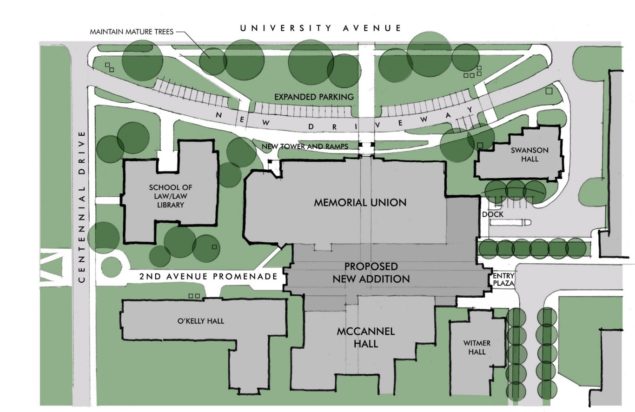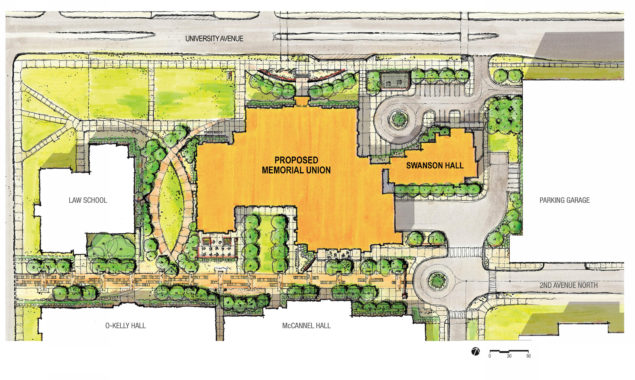News & Insights
Renovate or Replace? When the College Union Falls Short of Student Needs
January 18, 2021
It is a common refrain when student life professionals visit our booth at ACUI conferences – “Our building hasn’t had a major renovation in thirty (…or forty) years. Where do we begin? Do we renovate and add on, or should we consider replacement?”
This is the right place to begin, no matter why your union is falling short. Perhaps the building was originally built too small and planned future additions never came to fruition. Or maybe enrollment increases have outpaced the building size by leaps and bounds. Or possibly the size of the building is right, but the systems are outdated and insufficient for current student needs.
Whatever the reason, good direction can be determined by considering a number of factors and their relative costs. Some of this information will be at your fingertips, and other data may require consultation with campus facilities and maintenance staff or the university architect.
Funding
Let’s start with the least popular topic – money. This isn’t about setting a final budget or figuring out how much the process will cost, the reason to talk about money is to understand what is reasonable and common on your campus. What was the construction cost of the last new building and major renovation on campus? How many new construction and renovations projects have happened on your campus in the last 5-10 years? Understanding this data will help you start with realistic expectations, so your union dreams have a real chance of coming true.You should also figure out where the money can come from. Will this project need to be funded by a student fee and approved through a student referendum? Or would it be a capitol project approved by the Board of Trustees? The funding source and approval process can vary widely from campus to campus, and many state schools need to receive input from the state legislature. Similar to the previous point, an understanding of the process will help direct the process towards success.
Architecture
Another significant factor is the architecture of the student union and how it contributes to the architectural fabric of the campus. If your union is one of the oldest buildings on your campus, or has an historic designation, then this question is easy. You are going to want to pursue renovation and look carefully at the possibility of additions that won’t detract from the historic design of the union and its contributions to the campus architecture.At the other end of the spectrum, your union might have few architectural features or limited similarity to other campus structures. Unless it was designed by a notable architect or presents a distinctive and well-rendered example of a specific architectural style, you can proceed with the notion that replacement or renovation are on the table. The university architect on your campus would probably love to have a chat about the architectural design of the union and whether or not it contributes to the campus fabric.
Accessibility
Many college unions were built before the Americans with Disabilities Act (ADA) was finalized and accessibility requirements were added to building codes. From low guardrails to floor level changes, and from tiny elevators to small toilet compartments, there are a long list of accessible standards that older buildings don’t meet. Some standards are easy to meet in a renovation, and others are so difficult and costly than full replacement is a better solution.This is one area where you are going to need input from a licensed architect. There is a lot of grey area in applying accessibility requirements to existing buildings and building renovations, and many options will need to be weighed against each other. Prioritizing access in main program spaces and ensuring accessible entrances from each campus circulation path is often the place to begin, but nearly everything that is updated will need to be made accessible and some improvements will be harder to accomplish in phases. Even making one seemingly small change can sometimes trigger a lot of requirements.
A quick example – let’s say that you decide to upgrade the restroom plumbing fixtures in your building to be the correct height & configuration for accessibility. If you do this as a part of a large renovation project, you would also need to make sure that there is a path to those restrooms that are now accessible and provide all the accessories – mirrors, soap dispensers, etc – at the correct heights as well. What was going to be a simple swap out of equipment turns into a much larger scope. It is important to budget for that from day one, or to consider limiting how many restrooms get that upgrade.
Hazardous Materials
This is often the least exciting and most suspenseful part of every renovation project. An assessment and testing must be done to determine what materials in the building contain asbestos, lead, PCBs, and more. These materials were used in many kinds of building materials for decades before scientist determined their danger to public health. Insulation, floor finishes, sealants, mortar, pipes, and paint are the most likely components that will need to be abated following specific guidelines and protection practices, before the rest of the demolition process can continue unimpeded.The cost and time to abate materials can be tricky to estimate before the construction team gets in to do the work. Sometimes removal is more time intense than expected or unexpected materials are found during demolition. Don’t let concerns about hazardous materials prevent you from getting started. Understand that it will be a line item in your budget that won’t result in visible improvements, but it will make your building safer to use and occupy. Substantial materials to be abated may be a reason to lean toward replacement since abatement crews will have to work more slowly and carefully if a lot of other components in their work area are being saved for the renovation.

The initial Memorial Union study at the University of North Dakota investigated an addition/renovation scheme, but the estimate approached $120 million in order to replace systems, abate hazardous materials and make the building accessible.
Systems
The interesting thing about evaluating mechanical, electrical, and plumbing systems is that this is best done in collaboration with input from several groups. The architects and engineers will look at the existing systems to understand how efficient they are compared with current products, what components do and don’t meet code requirements, how sustainable the systems are in comparison with contemporary design standards, their age, and how they integrate with the rest of the building and proposed renovations. Maintenance staff bring an understanding of how easy the existing systems are to maintain, how frequently components require replacement, and how easy or hard the component replacements are to source. Building Operations staff know what rooms are too hot or too cold, which light fixtures need frequent bulb replacements, and what areas have the longest list of deferred maintenance items. Campus facilities staff understand the full complement of utilities on campus, what systems have been installed in recent years on other buildings, and university standard systems & sustainability goals.The design team will bring all of this knowledge together to assess the existing systems. Both the deferred maintenance and the overall costs to update these systems can be quantified and compared against the renovation costs for walls, finishes, and equipment that building users will see. A common reason to replace buildings instead of renovating is because the cost for deferred maintenance, sprinkler systems, and new HVAC systems is as much as 1/3rd of the renovation budget. In that case, building new can be less expensive in the long run and more of the budget can be spent on visible building elements, which will make students and donors happy.
Conversely, if the campus has regularly invested in equipment replacement and upgrades, and has added sprinklers, electrical infrastructure & capacity, LED lighting, etc, it could make much more sense to renovate the existing building. That kind of regular investment is embedded energy in the building, and it would be unfortunate to demolish systems that have 10 or 15 more years of useful life in them.

A follow-up study was requested to compare building replacement to the addition/renovation scheme. The result is an $80 million new Memorial Union, currently under construction, that will meet student needs, improves functionality for building service, and will be fully accessible.
Efficiency
The building shell will affect how efficiently HVAC systems can operate and how large they need to be. Modern building envelopes are designed tightly to limit water, vapor, and air from entering the building. If the existing façade can be modified to increase insulation, replace windows & doors, and keep water out, then renovation could be favorable. Other choices like increasing roof insulation, repointing brick, replacing sealants, and adding canopies can also lengthen the life of your existing building and lower the burden on your building systems.Another efficiency to consider is building and circulation efficiency. A 40 or 50 year old building was likely designed for much different programming and use than students need and desire now – with more individual rooms, lower floor heights, and fewer windows. By designing an accessible, open, tall, and flexible building with clear circulation from scratch, the result can be a smaller building footprint than a program of additions and several phases of renovation.
Campus Culture & History
Are there any architectural elements that your students and alumni identify with your union? A bell tower seen in most campus images, or funky stair with good acoustics, or the statue with the nose to touch for good luck, or maybe a basement club with signatures on the wall. Lots of campuses have signature elements like this, and some are an impediment to renovation, and others are items that can be relocated and celebrated in a new way in a new building. Creative thinking can maintain that campus treasure without sacrificing the benefits of updating or replacing the union.The design process may expose elements of campus culture that are just marketing. If that statue with a shiny nose is mentioned by the campus tour guides as providing luck, but no alumni are ever seen rubbing it, and no students mention it during the design process, then this is not a piece of the campus community that the project needs to embrace. You can learn a lot about the campus culture through the exploration of union improvements.
By Amy Maceyko, Associate Principal, WTW Architects
Thank you for visiting our website. Please contact Amy Maceyko if you have further questions on this topic at amaceyko@wtwarch.com